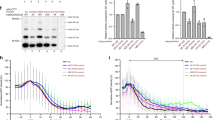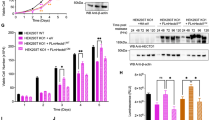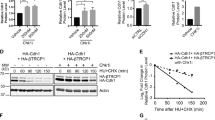Abstract
The temporal control of mitotic protein degradation remains incompletely understood. In particular, it is unclear why the mitotic checkpoint prevents the anaphase-promoting complex/cyclosome (APC/C)-mediated degradation of cyclin B and securin in early mitosis, but not cyclin A1,2,3. Here, we show that another APC/C substrate, NIMA-related kinase 2A (Nek2A), is also destroyed in pro-metaphase in a checkpoint-independent manner and that this depends on an exposed carboxy-terminal methionine–arginine (MR) dipeptide tail. Truncation of the Nek2A C terminus delays its degradation until late mitosis, whereas Nek2A C-terminal peptides interfere with APC/C activity in an MR-dependent manner. Most importantly, we show that Nek2A binds directly to the APC/C, also in an MR-dependent manner, even in the absence of the adaptor protein Cdc20. As similar C-terminal dipeptide tails promote direct association of Cdc20, Cdh1 and Apc10–Doc1 with core APC/C subunits, we propose that this sequence also allows a substrate, Nek2A, to directly bind the APC/C. Thus, although Cdc20 is required for the degradation of Nek2A, it is not required for its recruitment and this renders its degradation insensitive to the mitotic checkpoint.
This is a preview of subscription content, access via your institution
Access options
Subscribe to this journal
Receive 12 print issues and online access
$209.00 per year
only $17.42 per issue
Buy this article
- Purchase on Springer Link
- Instant access to full article PDF
Prices may be subject to local taxes which are calculated during checkout





Similar content being viewed by others
References
Harper, J. W., Burton, J. L. & Solomon, M. J. The anaphase-promoting complex: it's not just for mitosis any more. Genes Dev. 16, 2179–2206 (2002).
Castro, A., Bernis, C., Vigneron, S., Labbe, J. C. & Lorca, T. The anaphase-promoting complex: a key factor in the regulation of cell cycle. Oncogene 24, 314–325 (2005).
Peters, J.-M. The anaphase-promoting complex: proteolysis in mitosis and beyond. Mol. Cell 9, 931–943 (2002).
Lindon, C. & Pines, J. Ordered proteolysis in anaphase inactivates Plk1 to contribute to proper mitotic exit in human cells. J. Cell Biol. 164, 233–241 (2004).
Kops, G. J. P. L., Weaver, B. A. A. & Cleveland, D. W. On the road to cancer: aneuploidy and the mitotic checkpoint. Nature Rev. Cancer 5, 773–785 (2005).
Fang, G., Yu, H. & Kirschner, M. W. The checkpoint protein MAD2 and the mitotic regulator CDC20 form a ternary complex with the anaphase-promoting complex to control anaphase initiation. Genes Dev. 12, 1871–1883 (1998).
Geley, S. et al. Anaphase-promoting complex/cyclosome-dependent proteolysis of human cyclin A starts at the beginning of mitosis and is not subject to the spindle assembly checkpoint. J. Cell Biol. 153, 137–147 (2001).
den Elzen, N. & Pines, J. Cyclin A is destroyed in prometaphase and can delay chromosome alignment and anaphase. J. Cell Biol. 153, 121–135 (2001).
Gabellini, D. et al. Early mitotic degradation of the homeoprotein HOXC10 is potentially linked to cell cycle progression. EMBO J. 22, 3715–3724 (2003).
Hames, R. S., Wattam, S. L., Yamano, H., Bacchieri, R. & Fry, A. M. APC/C-mediated destruction of the centrosomal kinase Nek2A occurs in early mitosis and depends upon a cyclin A-type D-box. EMBO J. 20, 7117–7127 (2001).
Fry, A. M. The Nek2 protein kinase: a novel regulator of centrosome structure. Oncogene 21, 6184–6194 (2002).
Faragher, A. J. & Fry, A. M. Nek2 kinase stimulates centrosome disjunction and is required for formation of bipolar mitotic spindles. Mol. Biol. Cell 14, 2876–2889 (2003).
Hagting, A. et al. Human securin proteolysis is controlled by the spindle checkpoint and reveals when the APC/C switches from activation by Cdc20 to Cdh1. J. Cell Biol. 157, 1125–1137 (2002).
Glotzer, M., Murray, A. W. & Kirschner, M. W. Cyclin is degraded by the ubiquitin pathway. Nature 349, 132–138 (1991).
Pfleger, C. M. & Kirschner, M. W. The KEN box: an APC recognition signal distinct from the D box targeted by Cdh1. Genes Dev. 14, 655–665 (2000).
Hilioti, Z., Chung, Y. S., Mochizuki, Y., Hardy, C. F. & Cohen-Fix, O. The anaphase inhibitor Pds1 binds to the APC/C-associated protein Cdc20 in a destruction box-dependent manner. Curr. Biol. 11, 1347–1352 (2001).
Burton, J. L. & Solomon, M. J. D box and KEN box motifs in budding yeast Hsl1p are required for APC-mediated degradation and direct binding to Cdc20p and Cdh1p. Genes Dev. 15, 2381–2395 (2001).
Burton, J. L., Tsakraklides, V. & Solomon, M. J. Assembly of an APC–Cdh1–substrate complex is stimulated by engagement of a destruction box. Mol. Cell 18, 533–542 (2005).
Kraft, C., Vodermaier, H. C., Maurer-Stroh, S., Eisenhaber, F. & Peters, J. M. The WD40 propeller domain of Cdh1 functions as a destruction box receptor for APC/C substrates. Mol. Cell 18, 543–553 (2005).
Pfleger, C. M., Lee, E. & Kirschner, M. Substrate recognition by the Cdc20 and Cdh1 components of the anaphase-promoting complex. Genes Dev. 15, 2396–2407 (2001).
Zur, A. & Brandeis, M. Timing of APC/C substrate degradation is determined by fzy/fzr specificity of destruction boxes. EMBO J. 21, 4500–4510 (2002).
Passmore, L. A. et al. Doc1 mediates the activity of the anaphase-promoting complex by contributing to substrate recognition. EMBO J. 22, 786–796 (2003).
Yamano, H., Gannon, J., Mahbubani, H. & Hunt, T. Cell cycle-regulated recognition of the destruction box of cyclin B by the APC/C in Xenopus egg extracts. Mol. Cell 13, 137–147 (2004).
Carroll, C. W., Enquist-Newman, M. & Morgan, D. O. The APC subunit Doc1 promotes recognition of the substrate destruction box. Curr. Biol. 15, 11–18 (2005).
Uto, K. & Sagata, N. Nek2B, a novel maternal form of Nek2 kinase, is essential for the assembly or maintenance of centrosomes in early Xenopus embryos. EMBO J. 19, 1816–1826 (2000).
D'Andrea, L. D. & Regan, L. TPR proteins: the versatile helix. Trends Biochem. Sci. 28, 655–662 (2003).
Vodermaier, H. C., Gieffers, C., Maurer-Stroh, S., Eisenhaber, F. & Peters, J. M. TPR subunits of the anaphase-promoting complex mediate binding to the activator protein CDH1. Curr. Biol. 13, 1459–1468 (2003).
Wendt, K. S. et al. Crystal structure of the APC10/DOC1 subunit of the human anaphase-promoting complex. Nature Struct. Biol. 8, 784–788 (2001).
Grosskortenhaus, R. & Sprenger, F. Rca1 inhibits APC-Cdh1(Fzr) and is required to prevent cyclin degradation in G2. Dev. Cell 2, 29–40 (2002).
Reimann, J. D. et al. Emi1 is a mitotic regulator that interacts with Cdc20 and inhibits the anaphase promoting complex. Cell 105, 645–655 (2001).
Schmidt, A. et al. Xenopus polo-like kinase Plx1 regulates XErp1, a novel inhibitor of APC/C activity. Genes Dev. 19, 502–513 (2005).
Hames, R. S. et al. Dynamic recruitment of Nek2 kinase to the centrosome involves microtubules, PCM-1 and localized proteasomal degradation. Mol. Biol. Cell 16, 1711–1724 (2005).
Clute, P. & Pines, J. Temporal and spatial control of cyclin B1 destruction in metaphase. Nature Cell Biol. 1, 82–87 (1999).
Fry, A. M. et al. C-Nap1, a novel centrosomal coiled-coil protein and candidate substrate of the cell cycle-regulated protein kinase Nek2. J. Cell Biol. 141, 1563–1574 (1998).
Kramer, E. R., Scheuringer, N., Podtelejnikov, A. V., Mann, M. & Peters, J. M. Mitotic regulation of the APC activator proteins CDC20 and CDH1. Mol. Biol. Cell 11, 1555–1569 (2000).
Acknowledgements
The authors thank J. Pines and R. Patel for helpful comments on the manuscript; J.-M. Peters, P. Clarke and J. Gannon for providing reagents; and T. Hunt and H. Mahbubani for access to the Cancer Research UK Clare Hall Laboratories Xenopus colony. This work was supported by grants to A.M.F. from the Association of International Cancer Research, the Wellcome Trust, the BBSRC and Cancer Research UK. H.Y. and Y.K. were supported by the Marie Curie Cancer Care and the Association of International Cancer Research. C.L. is an MRC Career Development Fellow and is also supported by Cancer Research UK.
Author information
Authors and Affiliations
Corresponding author
Ethics declarations
Competing interests
The authors declare no competing financial interests.
Supplementary information
Supplementary Information
Supplementary Figures S1, S2, S3 and S4 (PDF 277 kb)
Supplementary Information
Supplementary Movie 1 (MOV 1328 kb)
Supplementary Information
Supplementary Movie 2 (MOV 3077 kb)
Rights and permissions
About this article
Cite this article
Hayes, M., Kimata, Y., Wattam, S. et al. Early mitotic degradation of Nek2A depends on Cdc20-independent interaction with the APC/C. Nat Cell Biol 8, 607–614 (2006). https://doi.org/10.1038/ncb1410
Received:
Accepted:
Published:
Issue Date:
DOI: https://doi.org/10.1038/ncb1410
This article is cited by
-
Separase-triggered apoptosis enforces minimal length of mitosis
Nature (2020)
-
Cyclin A2 degradation during the spindle assembly checkpoint requires multiple binding modes to the APC/C
Nature Communications (2019)
-
Cdc20/p55 mediates the resistance to docetaxel in castration-resistant prostate cancer in a Bim-dependent manner
Cancer Chemotherapy and Pharmacology (2018)
-
Erratum to: Controlling the response to DNA damage by the APC/C-Cdh1
Cellular and Molecular Life Sciences (2016)
-
Spatiotemporal regulation of the anaphase-promoting complex in mitosis
Nature Reviews Molecular Cell Biology (2015)



